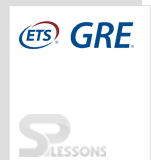 Introduction
Introduction
GRE General Test Quantitative Reasoning is primarily categorized into the below-mentioned topics. The GRE Multiple Choice Multiple Answers - Select One or More Answer choices category assesses the basic mathematical skills, understanding of the elementary mathematical concepts and ability to quantitatively reason and to model and solve problems with quantitative methods. GRE Multiple Choice Multiple Answers questions are multiple-choice questions that ask to select one or more answer choices from a list of choices. A GRE Multiple Choice Multiple Answers question may or may not specify the number of choices to select.
This article provides the detail information about the GRE Multiple Choice (Multiple Answer) of GRE General Test.
- Arithmetic- The topics include properties and types of integers, such as divisibility, factorization, prime numbers, remainders and odd and even integers; arithmetic operations, exponents and roots; and concepts such as estimation, percent, ratio, rate, absolute value, the number line, decimal representation and sequences of numbers.
- Algebra- The topics include operations with exponents; factoring and simplifying algebraic expressions; relations, functions, equations and inequalities; solving linear and quadratic equations and inequalities; solving simultaneous equations and inequalities; setting up equations to solve word problems; and coordinate geometry, including graphs of functions, equations and inequalities, intercepts and slopes of lines.
- Geometry- The topics include parallel and perpendicular lines, circles, triangles - including isosceles, equilateral and 30°-60°-90° triangles - quadrilaterals, other polygons, congruent and similar figures, three-dimensional figures, area, perimeter, volume, the Pythagorean theorem and angle measurement in degrees. The ability to construct proofs is not tested.
- Data analysis- The topics include basic descriptive statistics, such as mean, median, mode, range, standard deviation, interquartile range, quartiles and percentiles; interpretation of data in tables and graphs, such as line graphs, bar graphs, circle graphs, boxplots, scatterplots and frequency distributions; elementary probability, such as probabilities of compound events and independent events; conditional probability; random variables and probability distributions, including normal distributions; and counting methods, such as combinations, permutations and Venn diagrams. These topics are typically taught in high school algebra courses or introductory statistics courses. Inferential statistics is not tested.
-
✦ Quantitative Comparisons
✦ Single-Answer Multiple-Choice
✦ Multiple Answer Multiple-Choice
✦ Numeric Entry
✦ Data Interpretation
 Tips for MC
Tips for MC
GRE Multiple Choice (Multiple Answer) - Tips
- Note whether test takers are asked to indicate a specific number of answer choices or all choices that apply. In the latter case, be sure to consider all of the choices, determine which ones are correct, and select all of those and only those choices. Note that there may be only one correct choice.
- In some questions that involve conditions that limit the possible values of the numerical answer choices, it may be efficient to determine the least and/or the greatest possible value. Knowing the least and/or greatest possible value may enable test takers to quickly determine all of the choices that are correct.
- Avoid lengthy calculations by recognizing and continuing numerical patterns.
 Samples
Samples
Directions: Select one or more answer choices according to the specific question directions. If the question does not specify how many answer choices to select, select all that apply.
If the question specifies how many answer choices to select, select exactly that number of choices.
Question 1:
Which of the following integers are multiples of both 2 and 3?
Indicate all such integers.
- The correct answer may be just one of the choices or as many as all of the choices, depending on the question.
- No credit is given unless you select all of the correct choices and no others.
-
A. 8
B. 9
C. 12
D. 18
E. 21
F. 36
-
A. -20
B. –10
C. [latex]2^{-4}[/latex]
D. [latex]3^{-2}[/latex]





